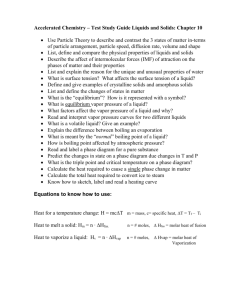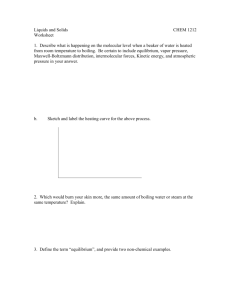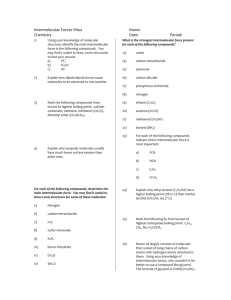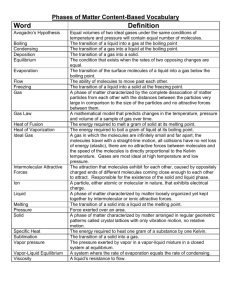CHM151\CHAPTER 11 INTERMOLECULAR FORCES
advertisement
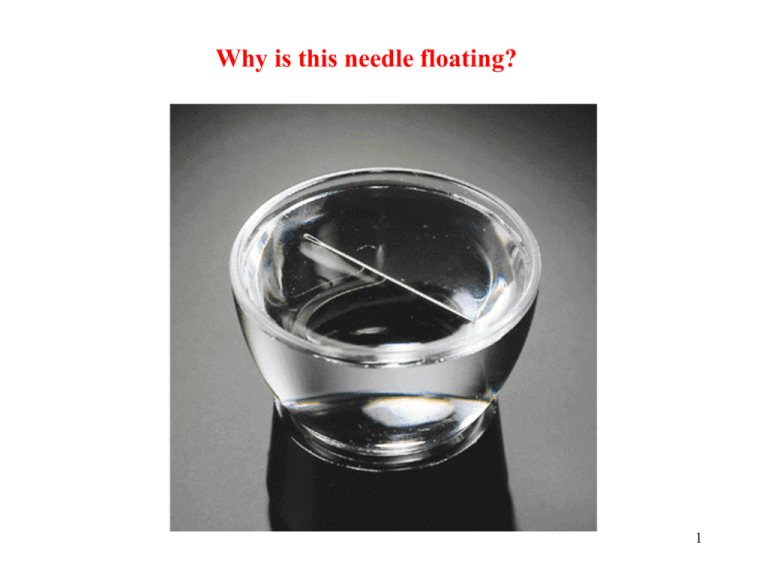
Why is this needle floating? 1 Intermolecular Forces: (inter = between) between molecules and the temperature (kinetic energy) of the molecules. What determines if a substance is a solid, liquid, or gas? 2 3 Gases: The average kinetic energy of the gas molecules is much larger than the average energy of the attractions between them. Liquids: the intermolecular attractive forces are strong enough to hold the molecules close together, but without much order. Solids: the intermolecular attractive forces are strong enough to lock molecules in place (high order). Are they temperature dependent? 4 The strengths of intermolecular forces are generally weaker than either ionic or covalent bonds. + 16 kJ/mol (to separate molecules) - + - 431 kJ/mol (to break bond) 5 Types of intermolecular forces (between neutral molecules): Dipole-dipole forces: (polar molecules) + .. S .. O : O .. - dipole-dipole attraction + .. S .. O : O .. - - What effect does this attraction have on the boiling point? 6 Polar molecules have dipole-dipole attractions for one another. +HCl----- +HCl- dipole-dipole attraction 7 Types of intermolecular forces (between neutral molecules): Hydrogen bonding: cases of very strong dipole-dipole interaction (bonds involving H-F, H-O, and H-N are most important cases). +H-F- --- +H-F- Hydrogen bonding 8 Hydrogen bonding is a weak to moderate attractive force that exists between a hydrogen atom covalently bonded to a very small and highly electronegative atom and a lone pair of electrons on another small, electronegative atom (F, O, or N). 9 10 Boiling points versus molecular mass 100 0 -100 Predict a trend for: NH3, PH3, AsH3, and SbH3 11 Predict a trend for: NH3, PH3, AsH3, and SbH3 Boiling Pt (Celcius) 0 -20 0 50 100 NH3 150 SbH3 -40 -60 AsH3 -80 -100 PH3 Molecular Weight (g/mol) 12 Boiling Pt (Celcius) Now let’s look at HF, HCl, HBr, and HI 40 20 HF 0 -20 0 NH3 -40 -60 -80 -100 50 100 SbH3 HI AsH3 HCl 150 HBr PH3 Molecular Weight (g/mol) 13 Types of intermolecular forces (between neutral molecules): London dispersion forces: (instantaneous dipole moment) ( also referred to as van der Waal’s forces) attraction - + - + “electrons are shifted to overload one side of an atom or molecule”. 14 polarizability: the ease with which an atom or molecule can be distorted to have an instantaneous dipole. “squashiness” In general big molecules are more easily polarized than little ones. little Big and “squashy” 15 Halogen Boiling Pt (K) Noble Gas Boiling Pt (K) F2 85.1 He 4.6 Cl2 238.6 Ne 27.3 Br2 332.0 Ar 87.5 I2 457.6 Kr 120.9 Which one(s) of the above are most polarizable? Hint: look at the relative sizes. 16 17 Other types of forces holding solids together: ionic: “charged ions stuck together by their charges” There are no individual molecules here. 18 Metallic bonding: “sea of electrons” Copper wire: What keeps the atoms together? Cu atoms an outer shell electron To which nucleus does the electron belong? 19 Metallic Bonding: “sea of e-’s” 20 Covalent Network: (diamonds, quartz) very strong. 1.42 Å 1.54 Å 3.35 Å What type of hybridization is present in each? 21 22 Name type of solid Ne Force(s) Melting Pt. (oC) Boiling Pt. (oC) molecular -249 -246 H2S molecular -86 -61 H2O molecular 0 100 Mercury metallic -39 357 W metallic 3410 5660 CsCl ionic 645 1290 MgO ionic 2800 3600 Quartz (SiO2) covalent network 1610 2230 Diamond (C) covalent network 3550 4827 23 Pentane isomers: C5H12 n-pentane iso-pentane neo-pentane Hvap=25.8 kJ/mol Hvap=24.7 kJ/mol Hvap=22.8 kJ/mol All three have the same formula C5H12 Why do they have different enthalpies of vaporization? London and “Tangling” 24 C-C-C-C C C C-C-C C iso-pentane Hvap=24.7 kJ/mol neo-pentane Hvap=22.8 kJ/mol n-pentane Hvap=25.8 kJ/mol London and “Tangling” 25 Structure effects on boiling points 26 Ion-dipole interactions: such as a salt dissolved in water cation polar molecule anion 27 28 Phase changes: solid liquid (melting freezing) liquid gas (vaporizing condensing) solid gas (sublimation deposition) 29 Energy changes accompanying phase changes 30 Heating curve for 1 gram of water 31 Heating curve for 1 gram of water Specific Ht. Steam = 1.84 J/g•K Hvap=2260 J/g Specific Heat of water = 4.184 J/g•K Hfus=334 J/g Specific Heat of ice = 2.09 J/g•K 32 Calculate the enthalpy change upon converting 1 mole of water from ice at -12oC to steam at 115oC. solid -12oC H1 solid 0oC + H2 liquid 100oC liquid 0o C + H3 + gas 100oC H4 + gas 115oC H5 = Htotal Sp. Ht. + Hfusion + Sp. Ht. + HVaporization + Sp. Ht. = Htotal Specific Heat of ice = 2.09 J/g•K Hfus=334 J/g Specific Heat of water = 4.184 J/g•K Specific Ht. Steam = 1.84 J/g•K Hvap=2260 J/g 33 Calculate the enthalpy change upon converting 1 mole of water from ice at -12oC to steam at 115oC. solid -12oC H1 solid 0oC + H2 liquid 100oC liquid 0o C + H3 + H4 gas 100oc + gas 115oc H5 = Htotal Sp. Ht. + Hfusion + Sp. Ht. + HVaporization + Sp. Ht. = Htotal Specific Heat of ice = 2.09 J/g•K Hfus=334 J/g Specific Heat of water = 4.184 J/g•K Specific Ht. Steam = 1.84 J/g•K 34 Vapor pressure 35 VAPOR PRESSURE CURVES A liquid boils when its vapor pressure =‘s the external pressure. 36 normal boiling point is the temperature at which a liquid boils under one atm of pressure. pressure = 1 atm vapor pressure = 1 atm liquid BOILING 37 PHASE DIAGRAMS: (Temperature vs. Pressure) gas and liquid are indistinguishable. critical temperature and critical pressure (all 3 phases exists here) 38 H2O CO2 note slope with pressure note slope with pressure 39 Crystal Structures: 40 unit cells: contains 1 atom contains 2 atoms 41 42 43 44 45
